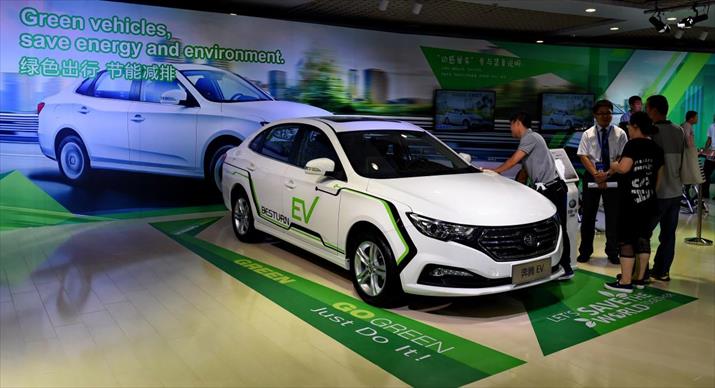 |
 |
| A sustained economic upswing |
| By Deng Yaqing |
The Chinese economy grew by 6.9 percent in the first quarter of 2017, a result widely attributed to industrial expansion, booming consumption and soaring exports. "China's economy continued to undergo stable growth in the first quarter, with major indicators scoring much better than expected. This bodes well for future developments for the rest of the year," said Mao Shengyong, spokesman of the National Bureau of Statistics (NBS), at a press conference held on April 17. More specifically, the added value of major industrial enterprises rose 6.8 percent in the first quarter, one percentage point greater than the figure recorded in the same period last year. Moreover, price levels were generally stable, with the consumer price index (CPI) and producer price index (PPI) increasing 1.4 percent and 7.4 percent, respectively, year on year. The employment sector's robust expansion was also a good sign, with 3.34 million people entering the workforce in urban areas--an increase of 160,000 people from the same period last year. Also, according to statistics from the NBS, the international balance of payments has improved, with the surplus in goods trade exceeding 450 billion yuan ($65.35 billion). "Credit for these improvements should go to structural adjustments in various sectors brought about by the supply-side structural reform," said Wan Zhe, chief economist of the International Cooperation Center of the National Development and Reform Commission, in an interview with China News Service. Besides that, hi-tech and equipment manufacturing industries saw their added value rise 13.4 percent and 12 percent, respectively, and online retail sales hit 1.4 trillion yuan ($203.3 billion), up 32.1 percent year on year. "Furthermore, a tentative global economic recovery has shored up global demand, and thus fueled the rapid growth of China's exports. The close contact and pragmatic cooperation between China and the U.S. as well as China's efforts in pushing forward collaboration with countries along the Silk Road Economic Belt and 21st-Century Maritime Silk Road are also positive factors," said Liu Dewei, a research fellow with the research institute of China Minsheng Bank, in an interview with China News Service. Propping up the economy In the first quarter, the manufacturing industry witnessed a year-on-year increase of 6.4 percent in added value, 0.5 percentage points faster than the same period last year, and contributed 36.1 percent to GDP growth, 1.1 percentage points more than the same period last year, according to statistics from the NBS. The growing contribution of consumption in GDP growth is another encouraging sign in the first-quarter figures. Consumption contributed 77.2 percent to economic growth, 2.2 percentage points more than that in the same period last year, according to the NBS. Total retail sales of consumer goods stood at 8.58 trillion yuan ($1.25 trillion) in the first quarter, up 10 percent year on year. Beyond that, there was a substantial increase in the contribution of exports to economic growth in the first quarter. "Though goods trade surplus went down 35.5 percent year on year in the first quarter, when taking the service trade into consideration and getting rid of the price factor, the net export of goods and services contributed 4.2 percent to economic growth in the first quarter," said Mao. What's worth noticing is the achievements made in the supply-side structural reform, said Mao. The rate of capacity utilization in China's major industrial enterprises was 75.8 percent in the first quarter, 2 percentage points higher than that in the fourth quarter last year, with their debt-to-asset ratio falling to 56.2 percent at the end of February. In the first quarter, investments in ecological protection and environmental governance, public facility management, agriculture and water conservancy management--weak areas of the Chinese economy--increased 48.1 percent, 27.4 percent, 24.6 percent and 18.3 percent respectively, much faster than the total investment growth of 9.2 percent, according to the NBS. Challenges "China's economic development is on the way toward more stability," said Mao, noting that stable growth doesn't necessarily mean no fluctuations or quarter-on-quarter growth, otherwise it's not in line with economic rules. "The robust economic growth had something to do with the violent surge of the real estate market last year. As regulators took measures to crack down on the skyrocketing property prices, this growth engine will be weakened to some extent," said Wan, who also predicted that price rises of upstream products caused by de-capacity efforts would gradually come to a halt. The prospect of domestic investment growth is uncertain, and private investment is still inactive, said Zhao Xijun, Associate Dean of the School of Finance with Renmin University of China, suggesting that stimulating economic vigor would be a major challenge for the rest of the year. Aside from that, the prospect of global economic growth is still uncertain, especially since U.S. monetary policy will have an impact on emerging markets like China, Zhao warned.  People stand next to an electric vehicle at an auto fair in Changchun, capital of northeast China's Jilin Province, on July 18, 2016 (XINHUA)
|
About Us | Contact Us | Advertise with Us | Subscribe
|
||
| Copyright Beijing Review All rights reserved 京ICP备08005356号 京公网安备110102005860号 |